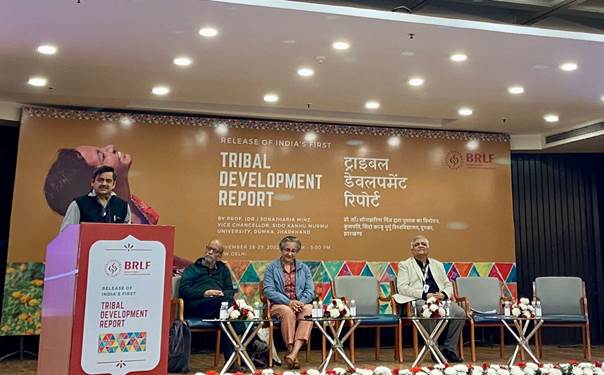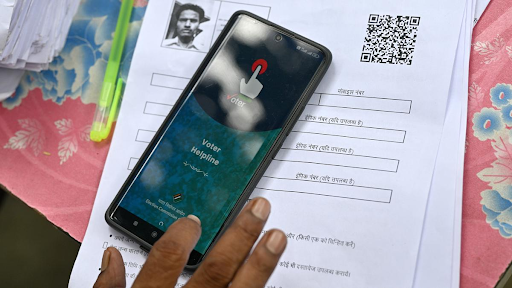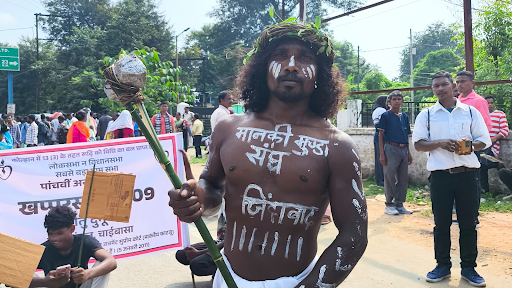Description

Copyright infringement not intended
In News
- The Bharat Rural Livelihood Foundation (BRLF) released the Tribal Development Report 2022.
- The report highlighted that according to the 2011 Census, India’s tribal communities form 8.6% of the country’s population, but they are at the bottom of the country’s development pyramid.
Details
- The report focuses on the status of tribal communities affecting livelihoods, agriculture, natural resources, economy, migration, governance, human development, gender, health, education, art, and culture at an all-India level and central India in particular.
- Central India is home to 80% of the tribal communities in the country.
- Bharat Rural Livelihood Foundation (BRLF) was set up by the Union Cabinet in September 2013 as an independent society under the Union Ministry of Rural Development.
Key Points of the Report
- Policymakers and leaders of the country need to understand that many tribal communities prefer isolation and silence. They are shy and are not going to reach out to the outside world on their own. Policymakers and leaders need to understand this trait and then work towards the welfare of Adivasis so that they connect with them in a better way.
- Tribal areas are also areas that have faced a lot of disturbance and conflict. This is one of the reasons why many government welfare schemes and policies are unable to take off in these areas.
- Indigenous communities of India have been pushed away from alluvial plains and fertile river basins into the harshest ecological regions of the country like hills, forests, and drylands.
.jpg)
About Tribal in India
- The Term “Tribal” literally means ‘original inhabitants’ – are communities who lived and often continue to live, in close association with forests. They are very old Communities, being among the oldest inhabitants of the Sub-Continent.
- They are not a homogeneous population: there are over 500 different tribal groups in India.
- Their societies are also the most distinctive because there is often very little hierarchy among them. This makes them radically different from communities organised around principles of jati-varna (caste) or those that were ruled by kings.
- They practise a range of tribal religions that are different from Islam, Hinduism and Christianity. These often involve the worship of ancestors, village and nature spirits, the last associated with and residing in various sites in the landscape – ‘mountain spirits’, ‘river spirits’, ‘animal spirits’, etc.
- They have their languages (most of them radically different from and possibly as old as Sanskrit), which have often deeply influenced the formation of ‘mainstream’ Indian languages, like Bengali.
- Santhali has the largest number of speakers and has a significant body of publications including magazines on the internet.
- In terms of language, tribes are Categorized into 4 Categories:
- Indo-Aryan
- Dravidian
- Austric
- Tibeto-Burman
- In terms of size, the biggest tribes are Gonds, Bhils, Santhals, Oraons, Minas, Bodos and Mundas.
- The total population of tribes amounts to about 8.6% of the population of India.
- Based on livelihood, tribes Can be Categorized into Fishermen, food gatherers and hunters, Shifting Cultivators, Peasants, Plantation and industrial workers.
- Tribal Society is a more egalitarian and kinship-based mode of Social organization.
- Tribals were not always the oppressed groups they are now; there were Several Gond kingdoms in Central India.
- Many of the So-Called Rajput kingdoms of Central and western India emerged through a Process of Stratification among Adivasi Communities themselves.
- Adivasis often exercised dominance over the Plains People through their Capacity to raid them, and through their Services as local militias.
- They also occupied a Special trade niche, trading forest Produce, Salt and elephants.
- Capitalist economics to exploit forest resources and minerals to recruit cheap labour has brought tribal Societies into Contact with mainstream Society a long time ago.
- They were losing their land to non-tribal immigrant Settlers, and their access to forests because of the government policy of reservation of forests and the introduction of mining operations.
Challenges faced by Tribals
- Land and forests were taken away from Tribal Societies in the name of development.
- Development involved the building of large dams, factories and mines. Because the tribal areas were located in mineral-rich and forest Covered Parts of the Country, tribals have paid a huge Price for the development of the rest of Indian Society. This kind of development has benefited the mainstream at the expense of the tribes.
- Forests Started to be systematically exploited in British times and the trend continued after Independence. The Coming of Private Property in the land has also adversely affected tribals, whose Community-based forms of Collective ownership were placed at a disadvantage in the new System.
- Many tribal Concentration regions and States have been experiencing the Problem of heavy in-migration of non-tribals. This threatens tribal Communities and Cultures, besides accelerating the Process of exploitation of tribals.
- In Tripura, the tribal Share of its Population halved within a Single decade, reducing them to a minority. Similar Pressure is being felt by Arunachal Pradesh.
- Many Tribals in the North-East States have been living for decades under Special laws that limit the Civil liberties of Citizens, States have been declared as ‘disturbed areas’.
- The vicious Circle of armed rebellions Provoking State repression which in turn fuels further rebellions has damaged the economy, Culture and Society of the North-eastern State.
.jpg)
Schemes for the development of Tribal
- The Pre and Post Matric schemes are demand-based schemes and every ST student whose family income is up to Rs 2.5 lakhs is entitled to a scholarship for pursuing education from class IX to Post Doctorate across India.
- The states send the proposal for the estimated expenditure during the financial year based on the expenditure incurred in previous years and advance up to 50% of the Central share is released to the States.
- After the State has disbursed the scholarship to the students and has submitted certificates, the balance amount is released to the State provided the State has contributed its share.
- Pradhan Mantri Adi Adarsh Gram Yojna:
- Comprehensive development of 36,428 villages will be undertaken to develop these villages as Adarsh Gram, under ‘Pradhan Mantri Aadi Adarsh Gram Yojana’.
- These villages have a tribal population of more than 500 and are 50% tribal.
- Pradhan Mantri Janjatiya Vikas Mission
- The Mission seeks to achieve livelihood-driven tribal development in the next five years through the formation of Van Dhan groups that have been organized into Vandhan Kendras.
- New haats bazaar and warehouses will be developed in the next 5 years as part of “Atmanirbhar Bharat Abhyan”.
- TRIFED would be the nodal agency for implementing the scheme. The products produced will be marketed through Tribe India Stores.
- Venture Capital Fund for STs
- An amount of Rs. 50 cr. has been sanctioned for the new scheme of ‘Venture Capital Fund for Scheduled Tribes’ (VCF-ST), which is aimed at promoting Entrepreneurship among the STs.
- The VCF-ST scheme would be a social sector initiative to promote ST entrepreneurship and to support and incubate the start-up ideas of ST youth.
- Central Sector Scholarship Scheme for ST students was introduced in the academic year 2007-08 to encourage meritorious ST students for pursuing studies at the Degree and Postgraduate level in any of the Institutes identified by the Ministry of Tribal Affairs for the purpose.
● Vocational Training Centers in Tribal Areas
- The main aim of this scheme is to upgrade the skills of the tribal youth in various traditional/ modern vocations depending upon their educational qualification, present economic trends and the market potential, which would enable them to gain suitable employment or enable them to become self-employed.
https://www.downtoearth.org.in/news/governance/adivasis-at-bottom-rung-of-india-s-development-pyramid-finds-tribal-development-report-2022-86268
https://t.me/+hJqMV1O0se03Njk9













